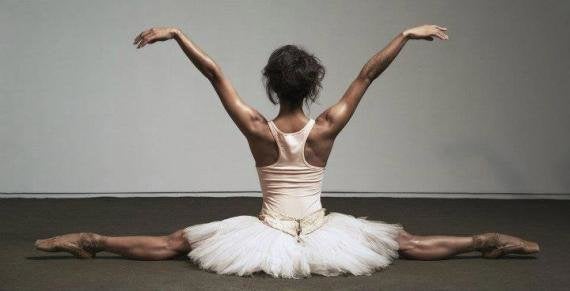It’s hard to say exactly why Sean Aaron Carmon stands out in a room full of people. It could be that he’s tall, a head and shoulders above some of his colleagues at the Alvin Ailey American Dance Theater. It could be his remarkably expressive face or the way he slinks when he walks, even when he’s just going to the side of the room to grab a sip from his water bottle.
It could be that Carmon stands out because he’s decided that he doesn’t want to fit in.
Carmon, 28, says that Ailey is the only company he ever wanted to join -- but that, for a long time, he didn’t want to dance with a company at all. He didn’t want to spend years of his dance career "in the back of a corps waving a rose back and forth." (And yes, “Center Stage” fans, he did use that exact quote in his interview with The Huffington Post.) In ballet, the measure of a good corps de ballet is often sameness: Is everyone dancing perfectly in sync? Is your arabesque exactly as high as everyone else’s? That didn’t sound like Carmon’s idea of a good time.
Carmon grew up gay in Beaumont, Texas, with a mother who is a devout Southern Baptist. He didn’t start taking ballet classes until he was 18, because he didn’t want to wear tights. “I didn’t want people staring at me,” he said.
A decade later, he doesn’t mind people looking at him, whether he’s in tights or drag or nothing at all. He is dancing in the corps, but Ailey’s corps, he explains, is a place where he doesn’t have to look or move exactly like everyone else. It’s the kind of company where magnetic stage presence like his -- the kind that landed him a role in a Tony-Award-winning musical -- is welcomed.
Perhaps it’s for that reason that Carmon, once so averse to joining a company, has become deeply invested in sticking up for the rights of his fellow dancers.
At a recent Friday rehearsal in Ailey’s giant building in Hell’s Kitchen, New York, there are 14 dancers in the studio, all of them men, all but two of them black. Carmon is the willowiest of them, the longest-limbed, the most mobile in the hips -- no small achievement in a room full of professionally flexible people.
In Adidas sweats and sneakers and a red-and-white raglan T-shirt with the company’s name on it, he doesn’t look like he’s dressed for a dance rehearsal, but the men around him are all dressed similarly as Artistic Director Robert Battle calls them into the center of the room to begin. "The Hunt" is a piece Battle choreographed: a dance for six men that conveys a kind of aggressive and violent masculinity you don’t usually associate with ballet.
The men throw themselves onto the ground, pound their feet into the floor, bare their teeth, and drag one another across the floor. It’s a punishing piece, set to loud drumming that’s occasionally punctuated by spontaneous grunting, which Battle encourages. During a much-needed break, as the men pant and peel off sweaty shirts, he explains how the dance got its title. Battle was half-watching television one exhausted night when, flipping through the channels, he landed on a show in which a man was talking about his strategy for picking up women in the club, which involved wearing a certain scent and "picking your target and finding its Achilles’ heel." The dancers nod, in amusement or discomfort, or both, as Battle talks. “He said, ‘I call it The Hunt.'”
The floor, as it happens, is an essential part of this dance, and this company. Dancers rehearse and perform on a vinyl mat called marley, which prevents them from slipping, and that’s laid over sprung floor to minimize the damage that landing jumps and, in this case, stomping and sprawling on the ground, does to bones and tendons. As dancers, it’s one of the few pieces of equipment they have onstage with them: shoes, costume, floor. That’s it.
And as a union delegate, part of Carmon’s job is to make sure that the third part of the equation is always there. “People who came before us have fought really hard to make sure that the standards are a certain way,” Carmon told HuffPost. “We tour with our floors, our sprung floors. We need certain marley to protect the dancers’ bodies.”
That means that wherever the company goes, whether it’s Louisville or London, the floor comes with them. That’s been the case for well over a decade. “The dancers fought for it,” Carmon told HuffPost. “They said, ‘OK, well, if we don’t have this, then we can’t perform. We’re not going to perform.’ And it was almost like a strike situation.”
A few years into Carmon’s time at the company, on tour in Oslo, dancers started complaining of injuries, and began to suspect that the floor they were dancing on was not, in fact, the marley they were used to -- and they turned out to be right. Their transportable home turf had not, in fact, made the trip to Norway.
The individuals who were acting as delegates at the time had a meeting with their fellow dancers to explain how hard the fight to secure the floor had been.
“They said, ‘We understand that some of you may not feel comfortable voicing your opinions and speaking out, but if we ask you to stand in solidarity with us, then we need to know that you’re going to do that.' Because if they have even one dancer that says, ‘Oh, I can do it,’ they’re going to say, ‘Well, why can’t everyone else?'"
Carmon finds the work of being a delegate taxing and thankless. "Frankly, it’s not nearly enough pay for the amount of work we do," he told HuffPost. But it's also vital. Because their work is so hard on the body, dancers have short careers as it is; most of them stop performing professionally before they hit 40.
Carmon started dancing at 13 years old, and his body has already sustained significant wear and tear, which is exacerbated by the fact that his feet aren’t built for dancing. He has low arches and his feet roll inward, the exact opposite of what’s required for classical and contemporary ballet. “I am constantly in pain,” he said, “and it’s something I’ve learned just to cope with, because these are the feet I have.”
Still, doctors have told him to be ready for his feet -- his already stretched-out ligaments -- to end his dancing career.
“They’re like, ‘When these go, that’s gonna be it for you, and no one wants to say this, but you should be prepared for that.'" Since a doctor told him that, three or four years ago, Carmon hasn’t taken a vacation. He’s been preparing for the inevitable end of his dancing days. He teaches workshops around the country and choreographs dances for competitions.
“People ask me why I don’t take time off ... in my time off, I schedule classes. I schedule choreography. I’m always traveling."
His feet, he said, are his own personal motivation to make sure he’ll still have a career in dance even when he can’t dance anymore, to ensure that he has something to fall back on.
“I’ve been very aware of the fact that this is not going to last forever," Carmon told HuffPost. And in the meantime, he’s looking out for his fellow dancers, and making sure they have the right ground beneath their feet.
In this series, The Huffington Post profiles some of the best ballet dancers in the world, working in some of the rarest and most unusual work environments imaginable, to try to understand how they deal with the same workplace issues that confront the rest of us mere mortals.
Most of us don’t get literal standing ovations from hundreds of people when we do good work. And most of us don’t have to visit the physical therapist at the beginning and end of every work day. But no matter what sector we’re in, the big questions are the same:
What does it mean to have your body under scrutiny on the job? How does it feel to be asked to represent your entire race in a company meeting? How do you find the right people to mentor and guide you? Read previous installments, about ballet's sexism problem, diversity in ballet, being a great partner, switching career tracks and navigating a workplace romance.
Alvin Ailey American Dance Theater will perform at the David H. Koch Theater at Lincokn Center until June 19.

